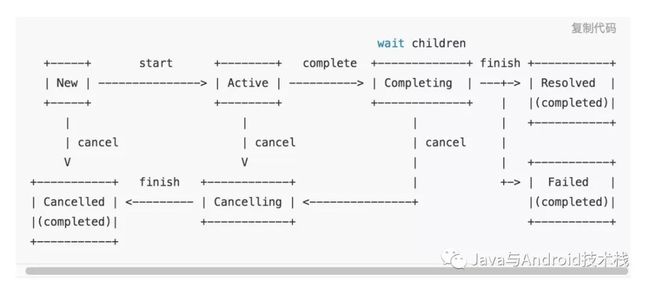Kotlin Coroutines 笔记 (一)
一. 协程
Kotlin 在1.1版本之后引入了协程的概念,目前它还是一个试验的API。
在操作系统中,我们知道进程和线程的概念以及区别。而协程相比于线程更加轻量级,协程又称微线程。
协程是一种用户态的轻量级线程,协程的调度完全由用户控制。协程拥有自己的寄存器上下文和栈。协程调度切换时,将寄存器上下文和栈保存到其他地方,在切回来的时候,恢复先前保存的寄存器上下文和栈,直接操作栈则基本没有内核切换的开销,可以不加锁的访问全局变量,所以上下文的切换非常快。
Kotlin 的协程是无阻塞的异步编程方式。Kotlin 允许我们使用协程来代替复杂的线程阻塞操作,并且复用原本的线程资源。
Kotlin 的协程是依靠编译器实现的, 并不需要操作系统和硬件的支持。编译器为了让开发者编写代码更简单方便, 提供了一些关键字(例如 suspend), 并在内部自动生成了一些支持型的代码。
先举两个例子来说明协程的轻量级,分别创建10w个协程和10w个线程进行测试。
import kotlinx.coroutines.experimental.CommonPoolimport kotlinx.coroutines.experimental.delayimport kotlinx.coroutines.experimental.launchimport kotlinx.coroutines.experimental.runBlocking/*** Created by tony on 2018/7/18.*/fun main(args: Array<String>) {val start = System.currentTimeMillis()runBlocking {val jobs = List(100000) {// 创建新的coroutinelaunch(CommonPool) {// 挂起当前上下文而非阻塞1000msdelay(1000)println("thread name="+Thread.currentThread().name)}}jobs.forEach {it.join()}}val spend = (System.currentTimeMillis()-start)/1000println("Coroutines: spend= $spend s")}
10w个协程的创建在本机大约花费 1 秒,经过测试100w个协程的创建大约花费11 秒。
import kotlin.concurrent.thread/*** Created by tony on 2018/7/18.*/fun main(args: Array<String>) {val start = System.currentTimeMillis()val threads = List(100000) {// 创建新的线程thread {Thread.sleep(1000)println(Thread.currentThread().name)}}threads.forEach { it.join() }val spend = (System.currentTimeMillis()-start)/1000println("Threads: spend= $spend s")}
10w个线程的创建出现了OutOfMemoryError。
二. 协程常用的基本概念
2.1 CoroutineContext
协程上下文,它包含了一个默认的协程调度器。所有协程都必须在 CoroutineContext 中执行。
2.2 CoroutineDispatcher
协程调度器,它用来调度和处理任务,决定了相关协程应该在哪个或哪些线程中执行。Kotlin 的协程包含了多种协程调度器。
2.3 Continuation
按照字面意思是继续、持续的意思。协程的执行可能是分段执行的:先执行一段,挂起,再执行一段,再挂起......
Continuation 则表示每一段执行的代码,Continuation 是一个接口。
2.4 Job
任务执行的过程被封装成 Job,交给协程调度器处理。Job 是一种具有简单生命周期的可取消任务。Job 拥有三种状态:isActive、isCompleted、isCancelled。
2.5 Deferred
Deferred 是 Job 的子类。Job 完成时是没有返回值的,Deferred 可以为任务完成时提供返回值,并且Deferred 新增了一个状态 isCompletedExceptionally。
2.6 suspend 关键字
协程计算可以被挂起而无需阻塞线程。我们使用 suspend 关键字来修饰可以被挂起的函数。被标记为 suspend 的函数只能运行在协程或者其他 suspend 函数中。
suspend 可以修饰普通函数、扩展函数和 lambda 表达式。
三. 协程的多种使用方式
Kotlin 的协程支持多种异步模型:
这些异步机制在 Kotlin 的协程中都有实现。
Kotlin 官方对协程提供的三种级别的能力支持, 分别是: 最底层的语言层, 中间层标准库(kotlin-stdlib), 以及最上层应用层(kotlinx.coroutines)。
3.1 协程的hello world版本
使用 launch 和 async 都能启动一个新的协程。
val job = launch {delay(1000)println("Hello World!")}Thread.sleep(2000)
或者
val deferred = async {delay(1000)println("Hello World!")}Thread.sleep(2000)
它们分别会返回一个 Job 对象和一个 Deferred 对象。
下面使用 runBlocking 来创建协程。
fun main(args: Array<String>) = runBlocking<Unit> {launch {delay(1000)println("Hello World!")}delay(2000)}
runBlocking 创建的协程直接运行在当前线程上,同时阻塞当前线程直到结束。
launch 和 async 在创建时可以使用不同的CoroutineDispatcher,例如:CommonPool。
在 runBlocking 内还可以创建其他协程,例如launch。反之则不行。
总结:
Kotlin 的协程能够简化异步编程的代码,使用同步的方式实现异步。协程的概念和理论比较多,第一篇只是一个开始,只整理了其中一些基本概念。
文末福利:《RxJava 2.x 实战》第二次印刷送书啦
关注【Java与Android技术栈】
更多精彩内容请关注扫码:






